Unit 3 Strategic Analysis: Understanding a Firm’s Competitive Environment

Overview
Strategy is a term often used in the world of sports. Take any sport, and the coaches develop strategies so their team can outsmart, outmaneuver, and win over competing teams. In sporting events, we often see coaches calling for a “time out” or “huddle” to rework their strategy, in light of how the game is progressing. The term strategy comes form the Greek word “strategos” – which means the way of the general, or the art of the general. While the word strategy has its founding in warfare and military, today it is used in every sphere where competition is part of the landscape and means a plan of action or policy designed to achieve a major advantage over the competition.
Similarly, organizations do not operate in a vacuum, but operate in an ecosystem (see the Dave Ulrich resources in Unit 2), where other competing organizations exist. Therefore, while managers must: (1) be mindful of the external and internal environments of the organization, (2) lead the teams forward during uncertain times, and (3) ensure that all resources are optimized towards fulfilling the vision and mission of the organization, managers must focus on competitors and the competitive environment.
In the external environment of the organization, there are global realities the organization must contend with. These are global trends and characteristics that all businesses must grapple with, irrespective of the industry or sector they operate in. However, there are other “industry-specific” external factors that the organizations must face, like competition from other organizations providing the identical products, services, experiences, etc.
At some point, the organization needs to ask questions like:
- “What global trends should we be mindful of?”
- “How are we different?”
- “Why would customers and clients prefer our products and services over those offered by our competitors?”
Such questions lead the organization to think about a strategy to deal with the competitive environment. Failure to address such questions can lead to becoming irrelevant, outmoded, customer migration, loss of revenue, etc. and eventually demise.
The competitive environment includes both external and internal factors. In this unit, we look at a few tools to assess the competitive environment of the organization.
Topics
This unit is divided into the following topics:
- Gaining Advantages by Understanding the Competitive Environment
- Using SWOT for Strategic Analysis
- Firms External Macro Environment – PESTEL
- Firms Internal Environment – Porters Five Forces
- Internal Environment
- Competition, Strategy, Competitive Advantage
- Strategic Positioning
Learning Outcomes
When you have completed this unit, you should be able to:
- Explain the use of PESTEL and other tools to assess the macro environment of an organization
- Describe the competitive environment of an organization.
- Explain the need for strategy and analyze the different competitive strategies
- Define an organization’s strategic position
Activity Checklist
Here is a checklist of learning activities you will benefit from in completing this unit. You may find it useful for planning your work. Expected time commitment: 2 hours
Learning Activities
- Read section 8.1 in your text, watch the videos, and apply your understanding to the scenario provided.
- Read Section 8.2 of your text and then choose an activity to practice and apply a SWOT analysis.
- Read section 8.3 in course text, including the LEGO case study, and apply the PESTEL analysis to the scenarios.
- Read section 8.4 of the text to further familiarize yourselves with how Porters Five Forces can be applied.
- Read section 8.5 of the text and use The Value Chain and VRIO as tools to assess the resources and activities of an organization.
- Read section 8.6 of the text and compare the strategies might be used by companies to differentiate from competition.
- Read section 8.7 in the text and practice key terms using the flashcards.
Assessment
- Unit 3 Discussion (Please confirm assignment instructions in Moodle)
Resources
- Bright, D. S. & Cortes, A. H. (2019). Principles of Management.
- Other online resources will be provided in the unit.
3.1 Gaining Advantages by Understanding the Competitive Environment
Humans love to win. Winning gives a good feeling and is tied to dopamine levels in our brains. Humans thrive on competition. Scoring well on exams, graduating top of the class, excelling in sports, success of debating teams all these point to the importance of winning. To win you need to have an advantage over your competitors. And to gain that advantage, there is always strategy – be it individually or as team. The strategy to gain that advantage might involve exploiting your strengths, developing your weakness, studying your competitors, etc. Similarly, as organizations compete for advantage, understanding the competitive environment is critical.
The following quote from the Chinese military general in his classic work “the art of war” sums our topic well:
“If you know the enemy and know yourself, you need not fear the result of a hundred battles. If you know yourself but not the enemy, for every victory gained you will also suffer a defeat. If you know neither the enemy nor yourself, you will succumb in every battle.”
- “Knowing the enemy” – external analysis
- “Knowing yourself” – internal analysis
Activity: Applying a Competitive Analysis Framework
In section 8.1, the text introduces two important concepts: strategic analysis, and the competitive environment. In this activity you will also be introduced to the CAT exercise that helps us understand elements of the competitive environment. In topic 2, we will unpack Strategic Analysis and look at some tools that will help.
- Read the section 8.1 and grasp the importance of these two concepts for an organization.
- Next, watch this short informative video that helps you understand the competitive environment by using the case of Amazon books Vs. Independent bookstores.
- Watch this micro video that introduces a helpful tool called the Competitive Analysis Template (CAT). The CAT helps examine how your organization stacks up against direct and indirect competitors. Once you familiarize yourself with the CAT, you will be able to create your own customized CAT for your organization.
- Finally, reflect on the connection between strategic analysis and competitive environment. To understand this better, and the importance of analysis in mapping out the competitor environment accurately, consider the following scenario:
Imagine you own a small business that sells art supplies. Walmart is right down the street and sells a similar product. How will you differentiate your business based on Walmart’s model? What does Walmart do well that you can apply to your own business?
- For further help, watch this video that shows three strengths of Walmart. How can you apply these strengths to your won business? Are there other strengths you can bring to the business as a small business that focused jut on art supplies?
- Consider jotting some ideas down in a Reflective Journal.
Note that the learning activities in this course are ungraded, unless specified. They are designed to help you succeed in your assessments in this course, so you are strongly encouraged to complete them.
3.2 Using SWOT for Strategic Analysis
At some point in our lives, we have used the SWOT frame and approach, though we may not have used the name SWOT analysis. When you evaluate something in your life (work, school, sports, relationships) and recognize the strong features (strengths), then look at areas you need to develop/improve (weaknesses), reflect on the opportunities you may have (opportunities), but also consider the limiting forces from outside (threats), and thought through a plan to overcome limitations and threats, you have pretty much done a SWOT analysis.
The SWOT analysis is an effective tool for Strategic Analysis. What is Strategic Analysis? It is the process of studying and analyzing the environments of an organization, to formulate strategies for the firm to develop and maintain a competitive advantage over its competitors, without compromising on the firm’s vision, mission, and core values. A SWOT analysis is used when a firm is planning to respond to a need in the market – caused by change or growth and needs to assess the chances for succeeding.
Reproduced below is exhibit 8.3 (section 8.2 from text) that spells out in details the elements that constitute an organizational SWOT. As one notes from the diagram, Strengths and Weakness are related to the internals of the organization, and Opportunities and Threats to the external aspects.
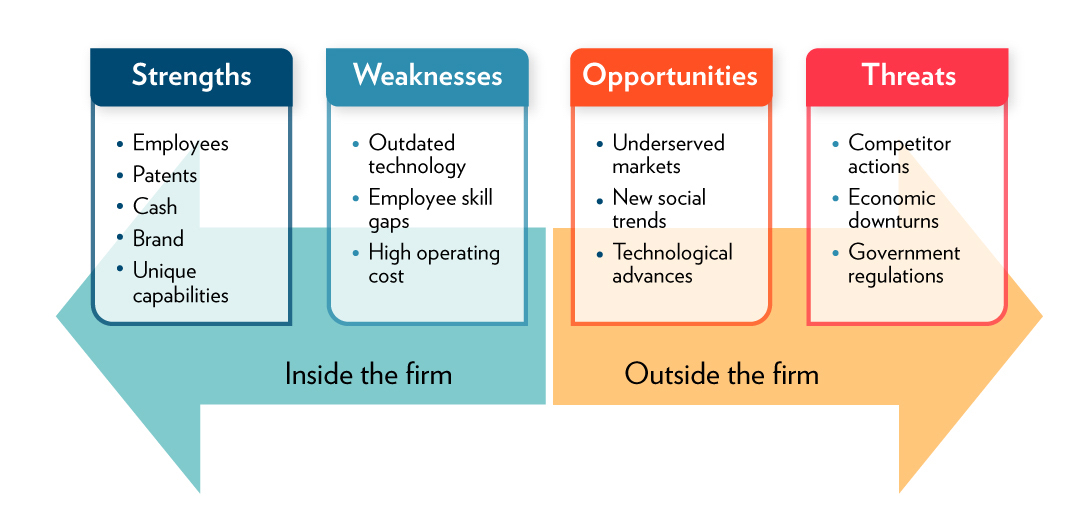
Attribution: Copyright Rice University, OpenStax, under CC-BY 4.0 license, Source
Activity: Applying SWOT
Read Section 8.2 of your text and then choose from the following to practice and apply a SWOT analysis.
- Use Figure 3.1 as a reference and compile a SWOT analysis for your organization.
- Use Figure 3.1 as a reference. Select three different businesses from different industries, such as a hospitality business (hotel, restaurant, fitness center), a manufacturing company, and a not-for-profit business. Perform a SWOT analysis for each business.
3.3 Firms External Macro Environment – PESTEL
While the SWOT analysis considers both the external and internal environments of the organization, the PESTEL analysis focuses on the external environment of the organization. In a broad sense, the world at large is the organization’s external environment. While the external environment cannot be controlled by the organization, the PESTEL assessment helps the organization be better prepared and make needed adaptations with the internal environment of the organization – like adding new teams, training and retraining staff, outsourcing some of the work, etc.
Figure 3.2 (reproduced below from text) provides a clear depiction of the PESTEL factors of an organization.
Important note: Observe and understand the macro (in blue) and micro (in pink) external environment of an organization.
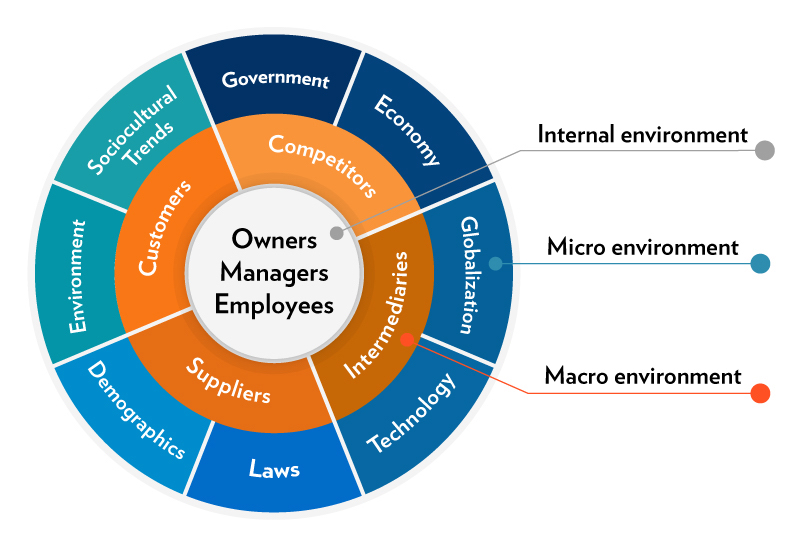
Attribution: Copyright Rice University, OpenStax, under CC-BY 4.0 license, Source
Exhibit 8.5 (reproduced below), provides further details of the PESTEL.
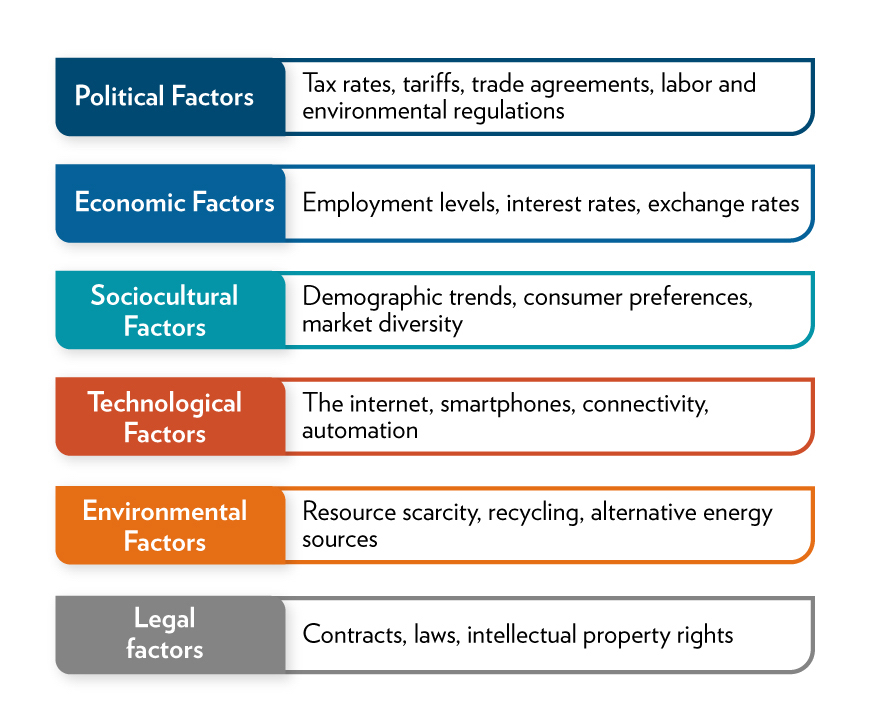
Attribution: Copyright Rice University, OpenStax, under CC-BY 4.0 license, Source
Activity: Applying PESTEL
- Read section 8.3 in course text, including the LEGO case – Ethics in Practice: Sustainability and Responsible Management: Can LEGO Give up Plastic? Answer the three critical thinking questions on the application of PESTEL.
- How would you approach this issue if you were the manager in charge of sourcing raw materials for LEGO? How would PESTEL analysis inform your actions?
- What PESTEL challenges is LEGO trying to address by changing the raw materials used in its products?
- Explain what favorable PESTEL factors support LEGO’s efforts.
- How would you approach this issue if you were the manager in charge of sourcing raw materials for LEGO? How would PESTEL analysis inform your actions?
- Perform a quick PESTEL analysis of the companies listed below. What is the largest risk for each of the companies? Assume that you had $100,000 to invest in one of more of these companies. Explain how you would allocate your investment and why you chose this particular allocation.
- Uber
- Tesla
- General Motors
- Uber
3.4 Firms Internal Environment – Porters Five Forces
In Topics 2 and 3, as we journeyed through the SWOT and PESTEL frames, you remember the macro and micro aspects of an organization’s external environment (Figure 3.2). In topic 4, we focus on the micro dimension of an organization’s external environment, The micro aspect of an organizations external environment relates to other firms operating and competing in the same industry. For example, if you were in the airline business, all other airlines competing in the same industry have an impact on your business. If in IT, other IT operations do have an impact on how you run your business. If in banking, all other financial institutions have a direct or indirect impact on your organization.
One simple yet effective tool developed to identify the main sources of competition in your industry or sector is Porters Five Forces. Developed by Professor Michael Porter of Harvard Business School, Porters Five Forces helps assess the impact forces “within the same industry” have on an organization. With this information, organizations can, adjust or reshape their existing strategies, scrap outmoded strategies, formulate new strategies to stay ahead of the competition.
\(\\\)
Porters Five Forces - Click to expand each topic below.
1. Industry Rivalry
This force looks at the number and strengths of your competitors; how many competitors there are and the quality of their products or services offered. If the rivalry is intense, with many strong players, then companies engage in price cutting, aggressive marketing campaigns to attract customers – which means profit margins could be lower. On the other hand, if there are few competitors and no one is offering the quality you offer, then you have a tremendous advantage.2. Threat of New Entrants
This threat deals with the ease/difficulty for new entrants to get into the market. If, with little money, little effort, and easy access key technologies and suppliers, companies can enter the industry, then your position can be weakened very easily. The higher and complex the barriers to entry, the more favourable your position in the industry.
3. Buyer Power
Buyer Power deals with number and ability of buyers. If the number of buyers is low and there are many suppliers, then the buyer has the power and can shift to another supplier for better service. When buyer power is high, suppliers use coupon schemes, discount/loyalty cards etc., to capture customers. When you have many customers and few suppliers, buyer power decreases.
4. Threat of Substitutes
This threat rises when customers find it easier to switch to another product that offers the same or better benefits. This could be driven by price or the better quality of the substitute. In recent times, the emergence of 3D printing where equipment/instruments can be turned out for a fraction of the cost, has traditional producers worried.
5. Supplier Power
Supplier Power considers the number and strength of suppliers. If there are only one or two agencies who supply your products or the raw material, then supplier power is strong and so is their ability to charge you more – since they do not have to worry about their own competition. This obviously impacts your profitability. However, if there are many suppliers, you have a range of suppliers to choose from and it will be easier to shift to a cheaper supplier.
\(\\\)
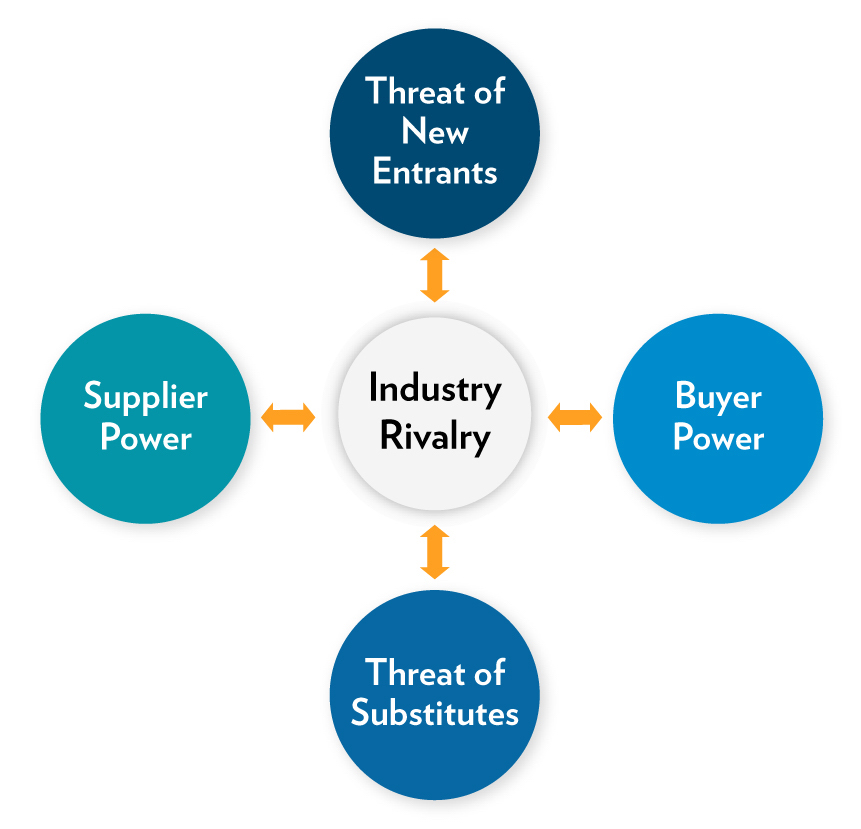
Attribution: Copyright Rice University, OpenStax, under CC-BY 4.0 license, Source
Activity: Apply Porter’s Five Forces Model
Read section 8.4 of the text to further familiarize yourselves with how Porters Five Forces can be applied. For a further explanation on Porters Five forces, watch the two videos below.
Think about the organization you serve, or an organization you are familiar with. Apply Porter’s Five Forces Model and ponder on how this will be of help to the managers in formulating strategy.
Watch: The Porter’s 5 Forces Model
Watch: A HBR interview with Prof Michael Porter himself
3.5 Internal Environment
The internal environment of an organization is composed of various elements “within” the organization. It includes, current employees, management, the structure of the organization, and the culture of the organization. The internal organization affects activities, choices and decisions made by the organization. Looking at the figure below and it becomes evident that the leadership of the organization plays a pivotal role in ensuring that the internal environment of an organization is stable and yet nimble to respond quickly to fast paced changes.
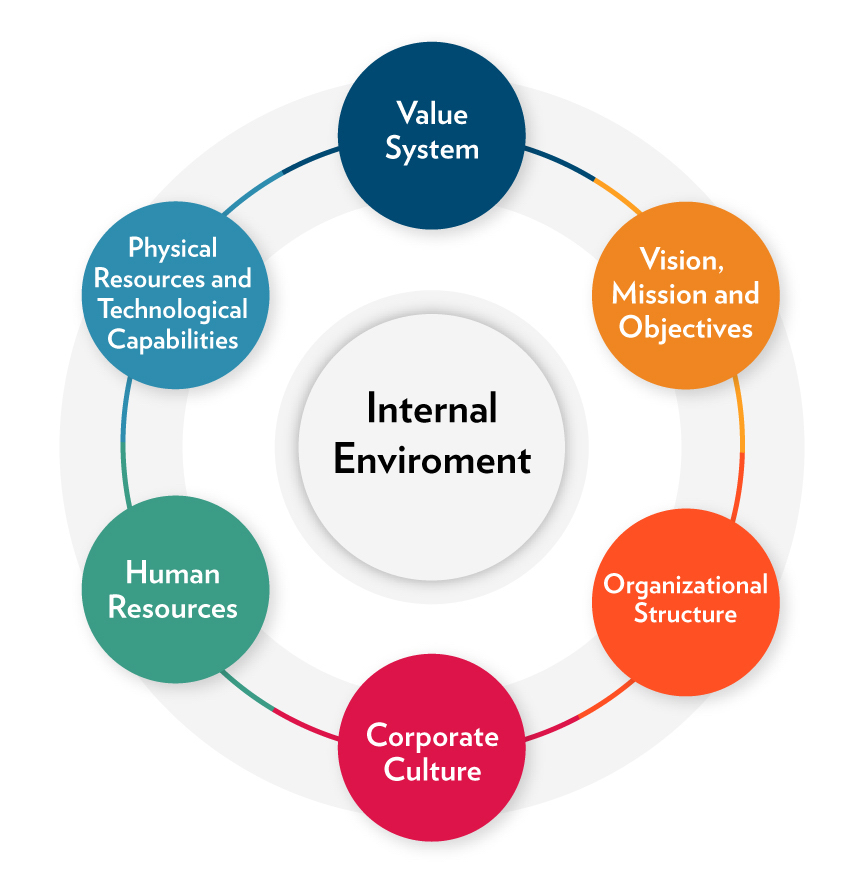
In this section, we look at two frames to help understand a firm’s internal environment and assess how ready the organization is, to cope with the external environment it operates in. Section 8.5 of the text provides a clear description of these two frames: The Value Chain and VRIO.
A firm’s value chain is the progression of activities it undertakes to create a product or service that consumers will pay for. Every link in the “chain”(from sourcing materials to market) adds value to stakeholders, in keeping with the mission, vision and core values of the organization.
As an example, see McDonald’s Value Chain Analysis. Understand the links and how at each link there is a value addition for the customer.
VRIO is another internal analysis tool that helps organizations to categorize their resources and capabilities in keeping with certain qualities outlined in the frame. VIRO is an acronym for value, rarity, imitation, and organization.
Before you read this section, watch this short video that explains the frame in detail.
Also, take a look at two examples of VRIO for Starbucks and Coca-Cola below:
VIRO Framework for Starbucks
| Resources or Capabilities | Valuable | Rare | Inimitable and non-substitutable | Organized to Exploit | Impact on Competitive Advantage |
|---|---|---|---|---|---|
| Strong Global Presence | Yes | Yes | Yes | Yes | Realized Sustainable Competitive Advantage |
| Specialty Coffees | Yes | No | No | Yes | Realized Competitive Parity |
| Upscale and Cozy Atmosphere | Yes | Yes | No | Yes | Realized Temporary Competitive Advantage |
VIRO Framework for Cocacola
| Valuable? | Rare? | Inimitable? | Organized? | Impact on Competitive Advantage |
|---|---|---|---|---|
| No | Competitive Advantage | |||
| Yes | No | Competitive Parity | ||
| Yes | Yes | No | Temporary Competitive Advantage | |
| Yes | Yes | Yes | No | Unused Competitive Advantage |
| Yes | Yes | Yes | Yes | Sustained Competitive Advantage |
Activity: Analyzing Your Organization
Now that you understand VRIO and the Value Chain Analysis, read section 8.5 of the text, and complete the following activity for our organization or an organization you are familiar with. Imagine you need to conduct an internal analysis of your organization. Use The Value Chain and VRIO as tools to assess the resources and activities of the organization you are analyzing.
Resources & Capabilities
| Resources | Capabilities |
|---|---|
Modified from Table 8.1 (Attribution: Copyright Rice University, OpenStax, under CC-BY 4.0 license)
Look at your list and pick a few of the resources and activities to evaluate with VRIO
Evaluating Starbucks’ VRIO
| Resources/ Capability | Is it valuable? | Is it rare? | Is it difficult to imitate? | Is Starbucks organized to capture its value? | Can it be a basis for competitive advantage? |
|---|---|---|---|---|---|
3.6 Competition, Strategy, Competitive Advantage
As shared before in this unit, competition is a reality of life and cannot be avoided. Competition exists in every sphere of our lives. When a limited set of resources are available, and many wish to avail themselves of these resources, competition becomes inevitable. Viewed positively, healthy competition brings out the best in all of us. It pushes us to do our best, gets our creative juices flowing, nudges us to think outside the box, and strive for excellence.
Similarly, competition is a key part of any industry or marketplace. Businesses must find ways to attract customers to their products and services, and away from their competitors’ offerings. This drives organizations to think of innovative ways to provide the best offering to their customers. Strategy is this process of planning and implementing actions and initiatives that will lead to gaining that edge to success for the organization.
Businesses use many strategies. It is not uncommon to find listings of 10 business strategies or more, in articles and videos. However, they are all hybrid versions or “combinations and permutations” of three generic level strategies, and these three strategies are attributed to the research of Prof Michael Porter. These three generic business strategies are outlined in Section 8.6 of the text and are: Cost Leadership, Differentiation, and Focus strategies.
Cost Leadership Strategy: is where an organization becomes the low-cost producer in the industry. It is about producing or providing service at a lower cost than all competitors. The organization could then: (1) offer the product/service at the same price as competitors and make larger profits, (2) lower the selling price below competitors and still make a profit. This strategy involves tight controls, eliminating waste, scale efficiencies etc.
Differentiation Strategy: as the name suggests, it about being different to the other organizations. It is about offering unique features in product/service for which the customer is wiling to prepare a premium. The unique feature(s) could be, quality of service, speed of service, longevity of product, etc.
Focus Strategy: where the business “focuses” on a specific group of buyers, a particular segment of the product, or geographic area. For instance, cars for disabled people, agriculture products for farmers in specific geographic area are opportunities use the Focus strategy.
Activity: Comparing Strategies
Read section 8.6 of the text and complete the following activity. Look at the list of well-known companies and compare the strategies might be used by these companies to differentiate from competition.
| Company #1 | Company #2 | Strategy |
|---|---|---|
| Starbucks | Tim Horton’s | |
| McDonald’s | KFC | |
| Apple | Microsoft | |
| Toyota | Mercedes | |
| Gucci | H&M |
3.7 Strategic Positioning
Having completed all the analysis using the assessment tools discussed, the manager must decide as to how the firm will serve the clients best and “make the competition irrelevant”. Making the competition irrelevant is a relatively new term. Traditionally, it was about “crushing” “defeating” or “outmaneuvering” the competition. But Chan Kim and Renee Mauborgne, professors of strategy at INSEAD, France, in their book, Blue Ocean Strategy, explain how to “make the competition irrelevant” by creating and capturing uncontested market space. The creation of this space involves strategic positioning.
Positioning is an important strategy as the firm interacts with a media – blitzed, skeptical society. Positioning involves the decisions and initiatives undertaken by the firm to target the customers mind space. If the product or service occupies the number one (or significant) space or spot in the customer’s mind, then the positioning of the product/service has been successful; it is about efforts taken by the firm to establish or lodge the message and the name of the product in a prominent place in the subconscious of customer (or prospective customer). Positioning is achieved through creative advertising, building upon current trends, and of course positive customer experiences serve to reinforce the position of the product/service in the client’s mind. The strategic position must be unique so that it cannot be imitated or copied by competitors. Some complex positioning strategies, “reposition” a strong competitor to look weak, thereby creating an entry point for their firm to the market.
For those interested in delving further into this exciting subject of positioning, let me recommend Positioning: the battle for your mind written by Al Ries and Jack Trout.
Activity: Key Terms Practice
Read section 8.7 in the text to understand more about strategic positioning and how strategic analysis leads to strategic positioning.
At the end of the 8.7 in the course text is a section titled key terms. Listed here are 46 terms related to this unit. Have a friend quiz you on these terms and see how well versed you are about organizational environment scanning and strategy. Score over 40 – exceptional; 30- 40 – good grasp of concepts; 20-30 – more work to be done.
For more practice, see the following flashcards:
Unit 3 Summary
In unit 3, you have had the opportunity to learn about:
- The elements that make up an organization’s external and internal environment
- The importance of a stable internal environment of an organization to overcome the challenges from the ever-changing external environment.
- Frames and tools to help assess an organizations readiness, and its strategic positioning as it seeks to optimize its resources to gain that edge over its competitors and offering superior service to all stakeholders.
- The importance of strategic positioning of a firm and its offerings in the minds of clients and potential clients.
Personal Application
Before participating in the assessment for this unit, consider how you might apply what you have learned.
- Discuss the role of the manager in determining the “fit” between organizational cultures, organizational structures, and the external environment.
- Read the case in Section 8.5 MANAGING CHANGE: Technology and Innovation: Uber, Lyft, and the Self-Driving Car: The Transportation of the Future Is Coming Soon and complete the three critical thinking questions.
- What PESTEL factors supported Tesla’s success? Which factors posed challenges?
- How has Tesla’s strategic position changed since it was founded in 2003?
- What kind of responses would you expect from Tesla’s rivals in the automobile manufacturing industry to the Model 3’s popularity?
Checking Your Learning
Before you move on to the next unit, you may want to check to make sure that you are able to:
- Explain the use of PESTEL and other tools to assess the macro environment of an organization
- Describe the competitive environment of an organization.
- Understand the need for strategy and analyze the different competitive strategies
- Define an organizations strategic